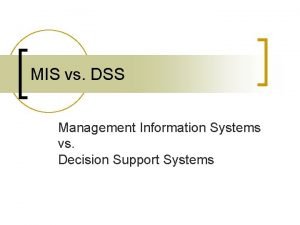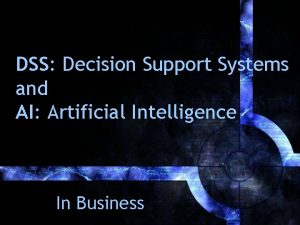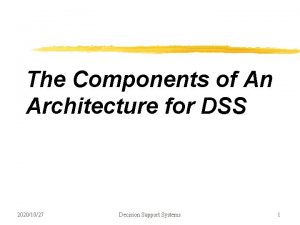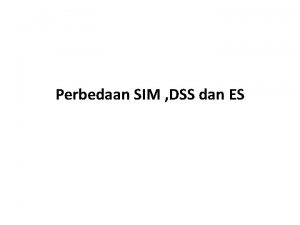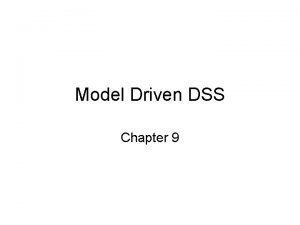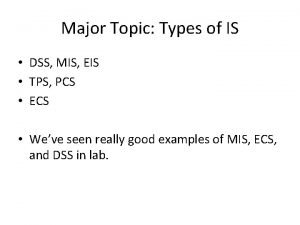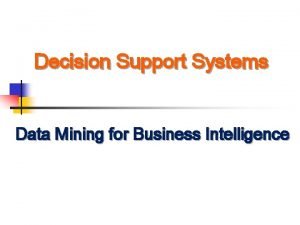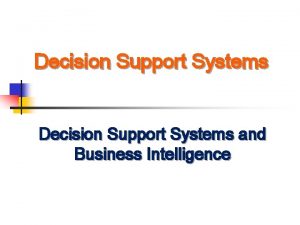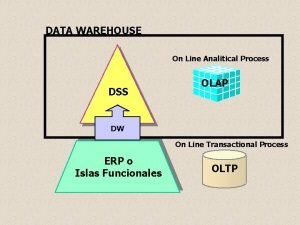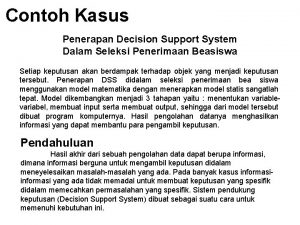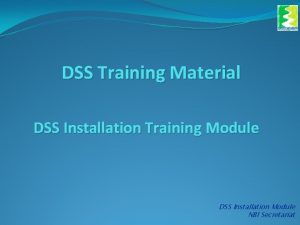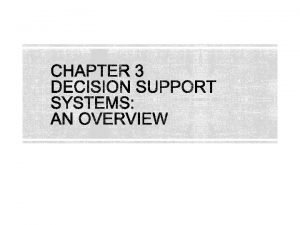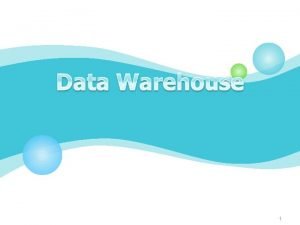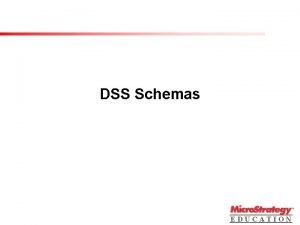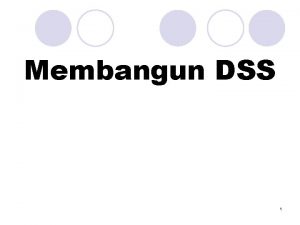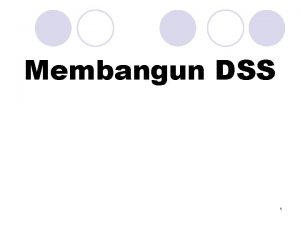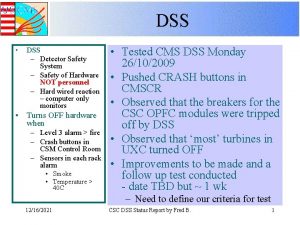WHAT IS A DSS Gorry and ScottMortons A



























- Slides: 27

WHAT IS A DSS ? Gorry and Scott-Morton’s: “A model based set of procedures for processing data and judgment to assist a manager in his decision making. ” According to them, to be successful, such system must be: - Simple - Robust - Easy to control - Adaptive - Complete on important issues - Easy to communicate with

Implicit in the definition is the assumption that : - The system is computer-based. - The system serves as an extension of the user’s problem solving capabilities. Gorry and Scott-Morton’s definition was accepted throughout most of the 1970’s by practitioners and researchers.

Several other definitions emerged from the literature : Alter (1980), Moore and Chang (1980), Bonczek, Holsapple, and Whinston (1980), Keen (1980) The tableau below provides a good summary of their various views: Source DSS defined in term of ____________________________________________________________________ Gorry and Scott-Morton Problem Type, System Function(support) Little System Function, Interface Characteristics Alter Usage Pattern, System Objectives Moore and Chang Usage Pattern, System Capabilities Bonczek et al System Component Keen Development Process

Working definition of an ideal DSS: A DSS is an interactive, flexible, and adaptable CBIS that utilizes decision rules, models, and model base coupled with a comprehensive database and the decision maker own’s insights, leading to specific, implementable decisions in solving problems that would not be amenable to management science optimization models per se. Thus, a DSS supports complex decision making and increases its effectiveness.

Type of Control

Intelligence Phase Organizational Objectives Reality Examination Search and scanning procedures Data collection Problem Identification Problem classification Problem statement Design Phase Validation of the model Formulate a model Set criteria for choice Search for alternatives Predict and measure outcomes Success Verification, testing of proposed solution Choice Phase Solution to the model Sensitive analysis Selection of best alternative Plan for implementation Design of a control system Implementation of solution Failure

Some Characteristics and Capabilities of DSS-I 1. DSS provides support for decision makers mainly in unstructured and semi structured situations. DSS is different from EDP, TP and MIS. 2. Support is provided for various managerial levels 3. Support is provided to individuals as well as groups - GDSS. 4. DSS provides support for interdependent as well as sequential decisions 5. DSS supports all phases of decision making process : Intelligence design, choice and implementation 6. Support is provided for a variety of decision problems. 7. DSS must be adaptive over time

Some Characteristics and Capabilities of DSS - Contd. 8. DSS should be easy to use. 9. DSS improves the effectiveness of decision making (accuracy, timeliness and quality) rather than efficiency (computer time close form solution). 10. Decision maker has complete control over all steps of the decision making process in solving the problems. 11. DSS leads to learning. 12. Should be easy to construct (? ) Should be easy to alter by its users.

Box 3. 2: The Major Benefits of DSS 1. Ability to support the solution of complex problems. 2. Fast response to unexpected situations that result in changed conditions. A DSS enables a thorough, quantitative analysis in a very short time. Even frequent changes in a scenario can be evaluated objectively in a timely manner. 3. Ability to try several different strategies under different configurations, quickly and objectively. 4. New insights and learning. The user can be exposed to new insights through the composition of the model and an extensive sensitivity “what if” analysis. The new insights can help in training inexperienced managers and other employees as well. 5. Facilitated communication. Data collection and model construction experimentations are being executed with active users’ participation, thus greatly facilitating communication among mangers. The decision process can make employees more supportive of organizational decisions. The “what-if” analysis can be used to satisfy skeptics, in turn improving teamwork.

Box 3. 2: The Major Benefits of DSS-continued 6. Improved management control and performance. DSS can increase management control over expenditures and improve performance of the organization. 7. Cost savings. Routine applications of a DSS may result in considerable cost reduction, or in reducing (eliminating) the cost of wrong decisions. 8. Objective decisions. The decisions derived from DSS are more consistent and objective than decisions made intuitively. 9. Improving managerial effectiveness, allowing managers to perform a task in less time and/or with less effort. The DSS provides managers with more “quality” time for analysis, planning, and implementation.

Support Provided by DSS may provide several types of support. The following structure is based on Alter(1). Each level of support contains and adds on the previous level (but may also contribute to the previous level). DSS Provides Raw data and status access General analysis capabilities Representation models (financial statements). Casual models (forecasting diagnosis). Solution suggestions, evaluation Solution selection Answers to Questions: What is. . . ? What is / Why. . . ? What will be / Why. . . ? What if. . . . ? What is best / What is good enough. . . ?

1 Semi structured decisions 14 Knowledge 2 For managers at different levels 13 3 For groups and individuals Modeling 12 4 Ease of construction Interdependent or sequential decisions DSS 11 5 Support, intelligence, design, choice Evolutionary usage 6 Support variety of decision styles and processes 10 Humans control the machine 7 9 Effectiveness , not efficiency 8 Ease of Use Adaptability and Flexibility

Components of DSS 1. Data includes database(s) which contains all the relevant data for the problem and is managed by software called database management system. 2. Model Management The software package that includes financial statistical, management science, other quantitative models that provide the system analytical capabilities, and an appropriate software management. 3. Communication(Dialog) Subsystem The subsystem through which the user can communicate with and command DSS These components contribute the software portion of the DSS. Also the manager(or user) is considered a part of the problem solving system.

Conceptual Model of DSS Other computer based systems Data: external and internal Data Model Management Knowledge manager Dialog management Manager (user) and tasks

The Capabilities of a DBMS in a DSS - Capture/extracts data for inclusion in a database - Quickly updates (adds, deletes, edits and changes) - Quickly retrieves data from database for queries and reports - Provides comprehensive data security ( protection from unauthorized access and recovery capability) - Handles personal and official data query - Performs complex retrieval and data manipulation tasks based on queries - Tracks usage of data

The Data Management Subsystem - DSS database - Database management system - Data directory - Query facility

Internal data sources External data Finance sources Marketing Dialog Model Management Production Extraction Query Decision support Management facility database Database Management System directory Other Private personal data Knowledge Data Personnel • Retrieval • Inquiry • Update • Report generation • Delete

On Data And Database System-I - Data external, internal and personal sources - External data are a available on thousands of online commercial databases, dictionaries, directories, reports, etc. - Data for DSS needs to be frequently in the field using one of the several methods - Data for DSS may have problems such as: incorrect data, non timely data poorly measured and indexed data, too many data or no data - Large online databases such as Compu. Serve and Dow Jones Information service can be a major source of DSS data. - DSS can be programmed with third-generation languages , but it is usually programmed with fourth-generation languages. - Fourth-generation system include many integrated features for data management - Data are organized either in a relational, hierarchical or network architecture. For many MSS relational type is preferable.

On Data And Database System - Contd. - SQL is a standard access to relational database - There is a trend to have DSS (and other MSS) distributed via networks - Distributed DSS provide the benefit of a PC and the power of a mainframe - Many DSS are being offered on client/server systems - Object-oriented databases are especially suitable for complex DSS such as those in computer integrated manufacturing - Object-oriented databases are easy to use and fast to access. They are especially useful in distributed DSS - Many companies are developing an enterprise-wide approach to data management. IBM’s Information Warehouse is an example

The model management subsystem - Model base management system - Model execution , Integration and command The ability to invoke run, change, combine and inspect models is a key capability of DSS which differentiates it from other CBIS.

The model base management system (MBMS) MBMS is a software system with the following functions : - Model creation - Using subroutines and other building block - Generation of new routines and reports - Model updating and changing - Data manipulation The MBMS is capable of interrelating models with appropriate linkages through a database.

Models (Model Base) • Strategic, tactical, operational Model • Statistical, financial, marketing, management science, accounting, engineering, etc. Directory • Model building blocks Model Base Management • Modeling commands : creation • Maintenance - update Model execution, integration and command processor. • Database interface • Modeling language Data Dialog Knowledge Management

Examples of Components of Models

The Model directory - It is similar to the role of database directory. - Contains the catalog of all models - Contains models definitions - Answers all questions about model’s capability and availability.

The Interface (Dialog) subsystem The dialog component is the software and hardware that provides the user interface for DSS. - Deals with the human-machine interactions - Uses action language to allow communication between user(s) and machine. - Uses presentation language - with graphic screen display…etc. - Uses knowledge base including information that the user must know.

Data Management and DBMS Knowledge Model Management and MBMS Dialog Generation and Management System-DGMS Natural Language Processor Input Action Output Display Languages Terminal Printers, Plotters User

Overall Capabilities • Create variety of DSS quickly and easily • Facilitate iterative design process General Capabilities Ease of use Access to a variety of analysis For routine use, modification and guidance data source, types, and formats for a variety of capabilities with some “suggestion” or construction of DSS problems and contexts. available. Component Capabilities
 James gorry
James gorry Gorry and scott morton grid
Gorry and scott morton grid Dss systems & software technologies ltd
Dss systems & software technologies ltd Dss vs mis
Dss vs mis A is a web based interface and integration of mis dss eis
A is a web based interface and integration of mis dss eis Difference between mis and dss
Difference between mis and dss Expert system and decision support system
Expert system and decision support system Undss
Undss Dss concept
Dss concept Dss architecture components
Dss architecture components Konsep dasar pengambilan keputusan
Konsep dasar pengambilan keputusan Perbedaan dss dan es
Perbedaan dss dan es Dss svl
Dss svl Dss8551
Dss8551 Model-driven dss
Model-driven dss Mis eis
Mis eis Dss 7016
Dss 7016 Dominios cobit
Dominios cobit Dss-soc
Dss-soc Dss algoritma
Dss algoritma Dss bolivia
Dss bolivia Dss security vulnerability assessment
Dss security vulnerability assessment Dss in data mining
Dss in data mining Dss in business intelligence
Dss in business intelligence Dss warehouse
Dss warehouse Model matematika
Model matematika Mdm support technologies in dss
Mdm support technologies in dss Expert system vs decision support system
Expert system vs decision support system



